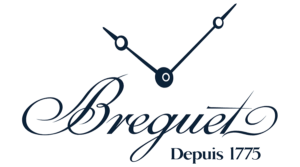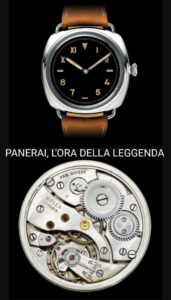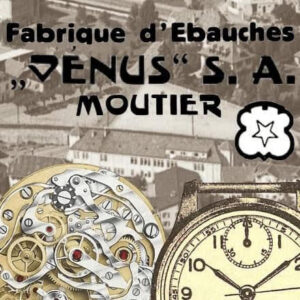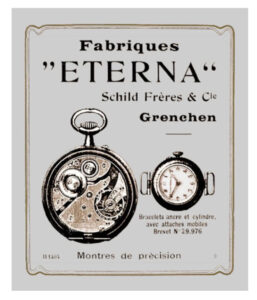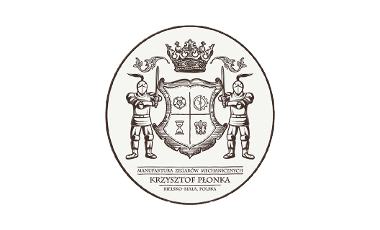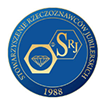ETERNA – ancestor of ETA
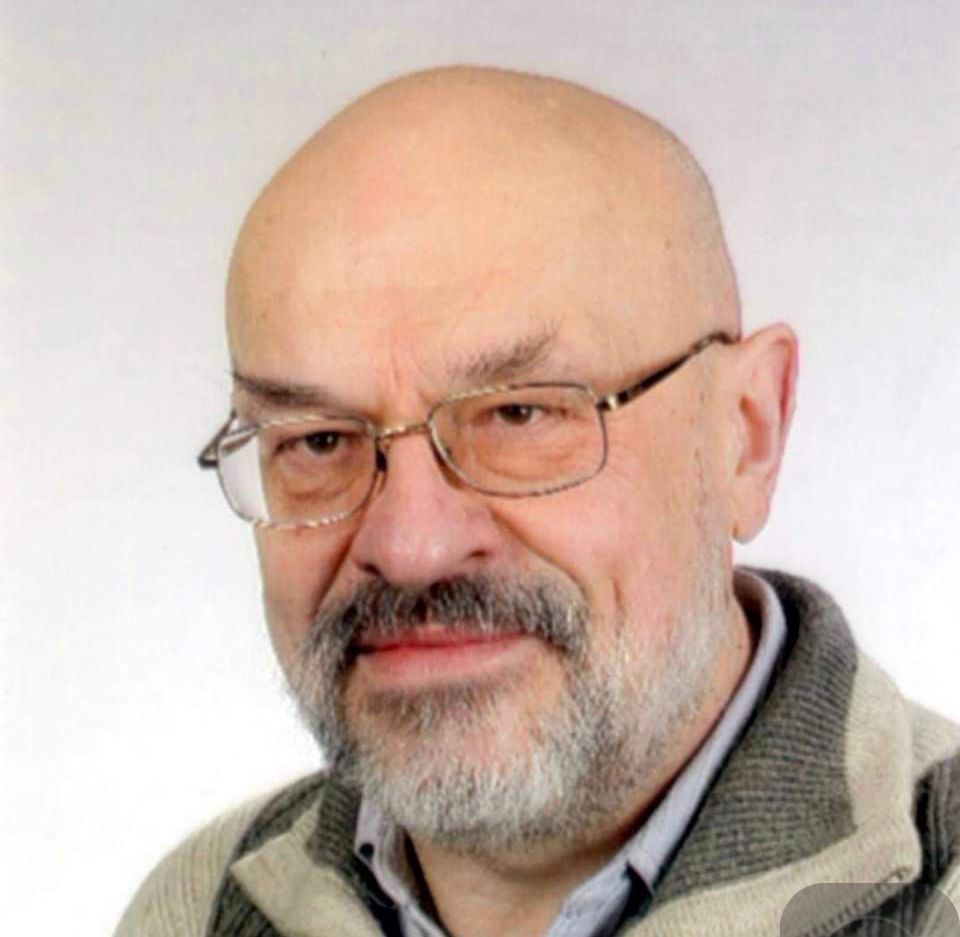
Piotr Ratynski
August 3, 2023
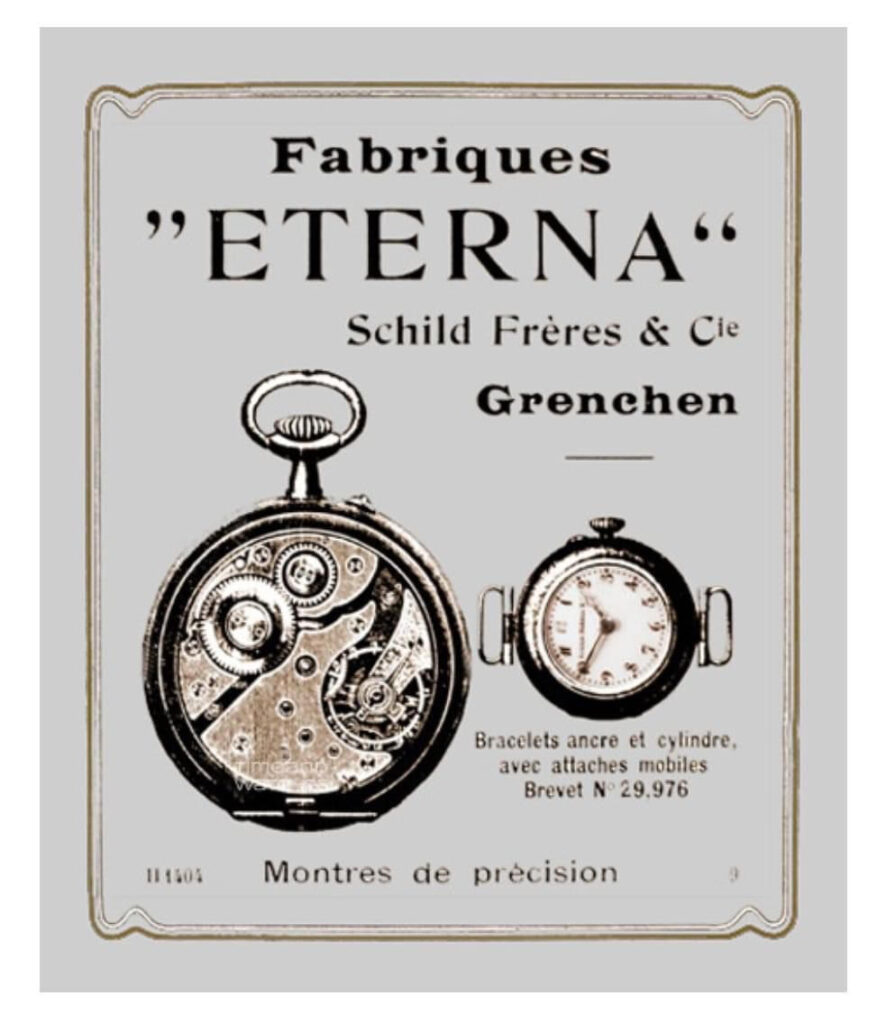
The brand’s history began in 1856, when Dr. Joseph Girard and Urs Schild, a 28-year-old school teacher, realized that with the emergence of the Swiss watchmaking industry, there was a major opportunity for a mechanism company. They founded the watch mechanism factory (ébauche) “Dr. Girard & Schild” in Grenchen (canton of Solothurn) and soon began producing both semi-finished mechanisms and fully finished mechanisms. Remaining the sole owner when Dr. Girard left the factory in 1866, Urs Schild modernized the production process, introducing the first automatic machines that could be powered not only by water from nearby streams, but also by a modern steam engine. When the production of ebauchs began to become less profitable due to the increase in supply and falling prices, Schild also began producing fully assembled watches. The first pocket watch, fully manufactured in Grenchen, was presented in 1876 and was a great success. To reflect this change and given that his brother Adolph had joined the company in the meantime, Urs renamed the factory “Präzisionsuhren-Fabrik Gebrüder Schild” (Schild Brothers Precision Watch Factory). The company was known as “Schild Fréres & Co.” When he was only 58 years old and one year after being elected to the National Council of the Swiss Confederation, founder Urs Schild died in 1888, and his two sons, Max and Theodore, took over the company. In 1890, when the company had about 300 employees and produced 180 watches every day, the “Eterna” logo began to appear on the dials of some watches as the name of the collection. A few years later, in 1906, Eterna was also adopted as the company’s new name: “Eterna-Werke, Gebrüder Schild & Co.”. The company expanded around the world, opening several branches while greatly increasing productivity with advanced production methodologies and innovative electrical machinery. Showing its innovative spirit, in 1904 Eterna filed a patent for a special watch envelope with movable safety strap protrusions designed for the armed forces. Four years later, a wristwatch with an alarm function was patented. Introduced at the Swiss National Exhibition in Bern in 1914, it was the world’s first mass-produced wristwatch with an alarm. The watch was further developed, and in 1929 a new model was introduced with a practical 8-day capacity. Eterna continued to break records and a year later unveiled the smallest production wristwatch with a Baguette movement: its caliber 610 was just 7.25 mm x 22.5 mm. Although other watchmakers had smaller models, they were handmade and much more expensive. In 1932, Theodor Schild, who had headed the company since 1899, died, and was succeeded by his brother Max’s son, Rudolf Schild Comtesse. That same year, the company was split into two legal entities: ETA SA for the manufacture of mechanisms and Eterna for the manufacture of watches. Over the years, ETA has become one of the largest manufacturers of ebauche mechanisms in the world. Today, ETA is a wholly owned subsidiary of the Swatch Group. The year 1948 was the year of a fundamental invention not only for Eterna, but for the entire watchmaking industry: the Eterna-matic mechanism. In 1920, John Harwood, a watchmaker in Bolton, England, came up with the idea of using a rotating weight, which rotated when the wearer moved, to wind the mainspring of a wristwatch. The weight did not rotate a full 360°, because the spring bumpers limited the pivot to about 270° (for this reason, this early type of self-winding mechanism is often referred to as a “bumper” or “buffer”). He obtained a patent for his invention in Switzerland, where he began producing automatic wristwatches that had the ability to run for 12 hours when fully charged. Other watchmakers worked to improve Harwood’s design. Among them, Rolex developed a new rotor-based system that could rotate 360° and capture much more energy with each revolution (up to 35 hours of operation on a full charge). However, the accuracy and reliability of these mechanisms were affected after a while by wear and tear caused by friction between components. Eterna found a solution that proved ideal, introducing a rotor mounted on ball bearings. Five miniature balls (only 0.65 mm in diameter each) provided the necessary support and balance to the rotor, significantly reducing bearing friction and making the watch run smoothly and reliably even under extreme conditions (for example, when the watch fell to the ground). From then on, all automatic watches produced by Eterna were sold under the name Eterna-matic, and the five tiny balls that brought the brand worldwide fame and success were chosen as the new logo of the manufacturer from Grenchen. This Eterna technology took watchmaking to a new level, soon becoming the new standard for all automatic wristwatches in the world, and is still in use today. Thanks to this key innovation, Eterna’s business will see exceptional growth over the next two decades. Following the innovation of the ball-bearing rotor, Eterna steadily improved its automatic movement, first miniaturizing it so that it could also work in women’s watches of much smaller size, and then slimming it down. The result of this work was the world’s smallest automatic-winding caliber, which powered the Eterna-matic Golden Heart for Ladies, so called from the inertial mass of the 23K gold rotor, guaranteeing excellent pulling power despite its small size. Design, technology, as well as the support of world-famous actresses such as Gina Lollobrigida and Brigitte Bardot helped make the model a worldwide success. That same year, Eterna launched a watch that would become a classic for the Grenchen watchmakers, the KonTiki. This water-resistant watch was designed to commemorate the 1947 expedition of archaeologist and ethnologist Thor Heyerdahl, who, along with five other scientists, set out from the Peruvian coast to the Pacific Ocean on a simple balsa raft named after the Incan sun god, Kon-Tiki. With his mission Heyerdahl wanted to prove that the pre-Columbian Indians of South America could have reached Polynesia with the help of the Humboldt Current and the Passat wind. With Eterna watches on their wrists, the six explorers completed their mission and reached Raroia Atoll in Polynesia after 101 days and nights of travel. In 1962, the Eterna-matic Dato 3000 set a new record as the world’s thinnest wristwatch with automatic winding and date. The mechanism was only 3.6 mm thick. Rudolf Schild Comtesse’s retirement in 1971, came at a difficult time for the Swiss watch industry due to the prevailing quartz crisis. Having stood at the head of Eterna (and ETA) since 1932 and often referred to as “Der Uhrenpatron,” Schild Comtesse left his mark not only on Eterna, but on the watch industry as a whole, serving on the board of directors of the category association, establishing watchmaking schools and by building his own foundation to promote cultural activities. In the years that followed, Eterna – along with other companies such as Certina, Longines, Mido, Oris, Rado and Rotary – joined the international group General Watch Co. (GWC), only to regain autonomy a few years later under the wing of Swiss industrialist Franz Wassmer, who integrated the brand into his group. As electronic watches gained prominence in the 1970s, Eterna introduced its first quartz watch in 1974, and in 1980 set a new record for the thinnest watch of all time with the Linea Museum quartz watch, measuring just 0.98 mm thick. The “Grand Prix Triomphe de l’Excellence Européenne” award received the same year was a well-deserved recognition of Eterna’s contribution to Europe’s influence on the rest of the world. After joining the F. A. P. Beteiligungs GmbH (“Porsche Design”) by Prof. Ferdinand Alexander Porsche, Eterna produces all Porsche Design brand watches. Despite the passage of years, Eterna continues to show its vocation for the development and production of advanced mechanisms and precision watches.
Similar Articles

Contact
Association for the Promotion and Development of Watchmaking
KRS 0000693567

It’s All About Watches Watch Fair © 2023. Do not attempt to Copy. | Privacy Policy | Design and Development: Wiseboost

